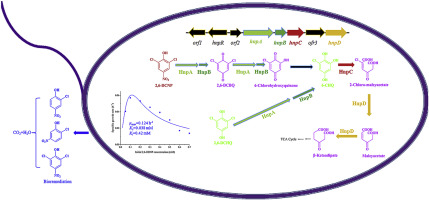Environmental Pollution ( IF 7.6 ) Pub Date : 2019-11-30 , DOI: 10.1016/j.envpol.2019.113703 Jun Min , Lingxue Xu , Suyun Fang , Weiwei Chen , Xiaoke Hu

|
2,6-Dichloro-4-nitrophenol (2,6-DCNP) is an emerging chlorinated nitroaromatic pollutant, and its fate in the environment is an important question. However, microorganisms with the ability to utilize 2,6-DCNP have not been reported. In this study, Cupriavidus sp. CNP-8 having been previously reported to degrade various halogenated nitrophenols, was verified to be also capable of degrading 2,6-DCNP. Biodegradation kinetics assay showed that it degraded 2,6-DCNP with the specific growth rate of 0.124 h−1, half saturation constant of 0.038 mM and inhibition constant of 0.42 mM. Real-time quantitative PCR analyses indicated that the hnp gene cluster was involved in the catabolism of 2,6-DCNP. The hnpA and hnpB gene products were purified to homogeneity by Ni-NTA chromatography. Enzymatic assays showed that HnpAB, a FAD-dependent two-component monooxygenase, converted 2,6-DCNP to 6-chlorohydroxyquinol with a Km of 3.9 ± 1.4 μM and a kcat/Km of 0.12 ± 0.04 μΜ−1 min−1. As the oxygenase component encoding gene, hnpA is necessary for CNP-8 to grow on 2,6-DCNP by gene knockout and complementation. The phylogenetic analysis showed that the hnp cluster originated from the cluster involved in the catabolism of chlorophenols rather than nitrophenols. To our knowledge, CNP-8 is the first bacterium with the ability to utilize 2,6-DCNP, and this study fills a gap in the microbial degradation mechanism of this pollutant at the molecular, biochemical and genetic levels. Moreover, strain CNP-8 could degrade three chlorinated nitrophenols rapidly from the synthetic wastewater, indicating its potential in the bioremediation of chlorinated nitrophenols polluted environments.
中文翻译:

Cupriavidus菌株对2,6-二氯-4-硝基苯酚的微生物降解动力学及分子机理
2,6-二氯-4-硝基苯酚(2,6-DCNP)是一种新兴的氯化硝基芳族污染物,其在环境中的命运是一个重要的问题。然而,尚未报道具有利用2,6-DCNP的能力的微生物。在这项研究中,Cupriavidus sp。先前已经报道CNP-8可以降解各种卤代硝基苯酚,已被证实也能够降解2,6-DCNP。生物降解动力学分析表明,其降解了2,6-DCNP,比生长速率为0.124 h -1,半饱和常数为0.038 mM,抑制常数为0.42 mM。实时定量PCR分析表明,hnp基因簇参与了2,6-DCNP的分解代谢。在使用hnpa和hnpBNi-NTA色谱将基因产物纯化至同质。酶测定法显示,HnpAB,一个FAD依赖性双组分单加氧酶,转化2,6- DCNP至6- chlorohydroxyquinol与ķ米3.9±1.4μM的和ķ猫/ ķ米的0.12±0.04μΜ -1分钟- 1。作为加氧酶成分编码基因,hnpA是CNP-8通过基因敲除和互补在2,6-DCNP上生长所必需的。系统发育分析表明,hnp团簇起源于参与氯酚而不是硝基酚分解代谢的团簇。据我们所知,CNP-8是第一个具有利用2,6-DCNP能力的细菌,这项研究填补了该污染物在分子,生化和遗传水平上的微生物降解机理的空白。此外,菌株CNP-8可以从合成废水中快速降解三种氯化硝基苯酚,表明其在氯化硝基苯酚污染环境的生物修复中具有潜力。

































 京公网安备 11010802027423号
京公网安备 11010802027423号